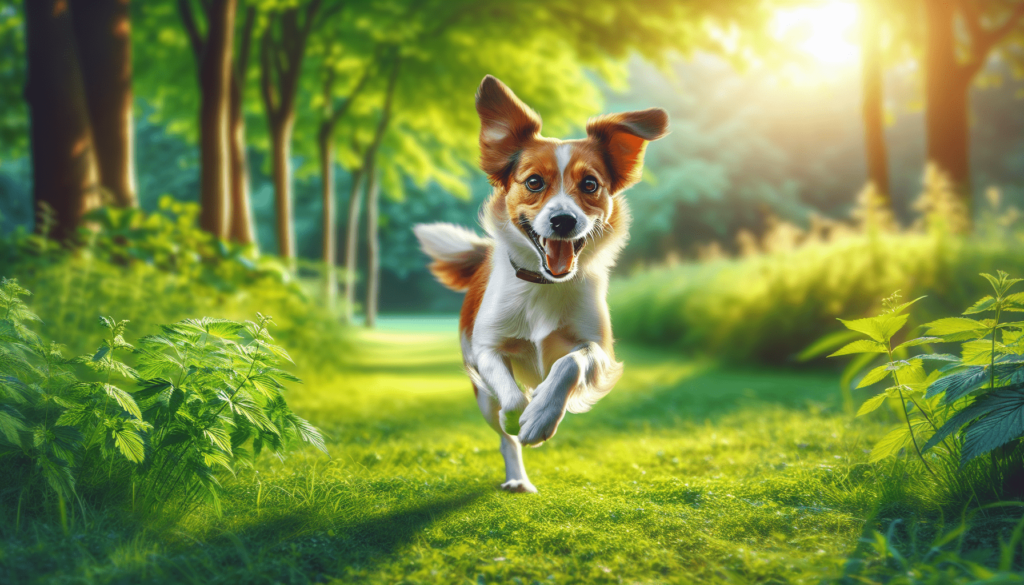Have you ever noticed your dog’s waistline expanding a little more than it used to? You’re not alone in wondering how to prevent a beloved dog from becoming overweight. In a world where treats abound and those puppy-dog eyes could win an Oscar for best persuasion, it’s easy for our canine companions to pack on a few extra pounds. But why is this such a big deal, and how can I help my dog maintain a healthy weight while ensuring they feel loved and satisfied? Let’s wag our way through some helpful tips and guidance.

Understanding the Importance of Maintaining a Healthy Weight in Dogs
Dogs, much like us, thrive best when they’re at a healthy weight. Carrying extra pounds can lead to a slew of health issues for dogs including diabetes, heart disease, joint problems, and a decreased lifespan. As responsible pet owners, it’s essential to prioritize our dog’s health and ensure that they maintain a suitable weight and overall wellness throughout their lifetime.
The Risks of Obesity in Dogs
Let’s chat about what can happen if our furry friends become overweight. When a dog carries extra weight, it puts additional stress on their joints and bones, which can lead to painful arthritis. Furthermore, an overweight dog can experience difficulty breathing, high blood pressure, and even certain types of cancer. Knowing these risks can motivate us to take preemptive measures and keep our pooches fit and healthy.
Benefits of a Healthy Weight for Dogs
Not only does maintaining an ideal weight help prevent health issues, but it also boosts your dog’s energy and vigor. Dogs at a healthy weight are often more active and playful, which enhances both their quality of life and your shared experiences. Moreover, it contributes to a longer and happier life, knowing that you’ve done your part in securing your pet’s well-being.
How to Determine If My Dog Is Overweight
Before jumping into prevention strategies, it’s crucial to assess whether my dog is already overweight. There are several ways to determine if a dog needs to shed a few pounds or maintain the current regime.
Visual Cues and Touch Assessment
One straightforward approach is the visual and touch assessment. Stand back and look at your dog from above. Can you see a clear waistline or does your dog’s shape resemble more of a barrel? When you gently run your hands over your dog’s sides, you should be able to feel their ribs—without pressing hard. These basic assessments can be a quick and easy way to gauge their weight.
Consulting the Body Condition Score
A more structured method involves using a Body Condition Score (BCS). This score is a tool veterinarians use that ranges from thin to obese, allowing a balanced perspective on optimal canine weight. It takes a holistic view, considering not only visible ribs but the overall body structure. If you’re unsure, it may be worthwhile to ask your vet to evaluate your pet’s BCS during regular check-ups.

Nutrition: Feeding Your Dog for Health
A cornerstone of canine weight management is appropriate and balanced nutrition. The secrets to healthy dog nutrition lie in understanding what my dog needs based on their breed, age, and activity level.
Choosing the Right Dog Food
Selecting the correct type of food is vital. With countless brands and formulations on the market, it’s essential to decipher labels and choose one that matches my dog’s needs. Opt for foods that are rich in high-quality proteins, have moderate fat content, and are replete with the necessary vitamins and minerals. Avoid foods laden with fillers and low-quality ingredients.
| Nutritional Component | Ideal for Dogs |
|---|---|
| Protein | High-quality animal sources like chicken, fish, or beef |
| Fat | Moderate levels for energy, from healthy sources like fish oil |
| Carbohydrates | Include complex carbs like sweet potatoes for energy |
| Fiber | Important for digestion, sourced from vegetables or whole grains |
The Role of Portion Control
Portion control is integral to preventing obesity. Overfeeding is common, especially when adjusting portion sizes is not done correctly as the dog ages or becomes less active. Always measure food based on the guidelines provided on the food packaging, but adjust accordingly if recommendations appear ineffective. Consulting your vet can help tailor portion sizes to better suit your individual dog’s needs.
Scheduled Feeding vs. Free Feeding
Deciding between scheduled feeding (offering meals at specific times) and free feeding (leaving food out all day) can also impact weight control. Scheduled feeding is usually better for weight management as it allows for portion control and avoids excessive snacking throughout the day. Plus, it can create more predictable habits that keep my dog’s digestive system healthier.
Exercise: Keeping My Dog Active and Engaged
Regular exercise is the other side of the coin in managing dog weight effectively. Beyond helping to control weight, exercise has multiple benefits for dogs, including mental stimulation and behavior improvements.
Finding the Right Type of Exercise
Choosing an exercise that my dog enjoys and can stick to is essential. It could be anything from daily walks to more vigorous activities like playing fetch, running, or even swimming. Tailor the intensity and frequency of the exercise to match my dog’s breed and health status. High-energy breeds like Border Collies and Labrador Retrievers might need more physical activity than a calmer or older dog might.
Encouraging Playtime
Incorporate fun activities to bond and burn calories simultaneously. Interactive games such as hide and seek, agility courses, or tug-of-war are excellent for providing mental and physical engagement. Don’t underestimate the power of spontaneous play; a short fifteen-minute wrestling match or a sprint around the garden can be just what my dog needs to break a sweat.
Setting Exercise Goals
Setting practical goals can help me maintain consistency in my dog’s exercise regime. Aim to gradually increase exercise time by a few minutes each week, keeping an eye on how my dog responds. Adjust these goals based on their current fitness level and remember, start slow and build up gradually.
Monitoring Weight and Health
A consistent weight and health-monitoring routine can keep me on top of my dog’s progress and make adjustments as needed. Recognizing signs of weight gain early can prevent it from becoming a more significant issue.
Regular Weigh-ins
Regular weigh-ins are an excellent way to see where my dog stands with their weight management. Many vet offices offer walk-in weigh-ins, but I can also do this at home if I have a pet-friendly scale. Keeping track of these weigh-ins over time can show progress and help in planning adjustments to diet or exercise.
Keeping a Health Diary
Maintaining a health diary can be a motivational tool. Tracking food intake, exercise routines, and weight changes provides a comprehensive overview of my dog’s health management strategy. It becomes handy to discuss with veterinarians during check-ups, helping them provide better-tailored advice.
Involving Professionals When Needed
At times, it might be necessary to seek professional help to manage my dog’s weight effectively.
Consulting a Veterinarian
Before initiating any weight loss or management strategy, consulting my veterinarian is prudent. They can offer essential insights, tailor diets specific to my dog’s health needs, and rule out any underlying health conditions contributing to weight changes.
Working with a Certified Pet Nutritionist
Pet nutritionists can also be valuable resources. They can create a customized eating plan that fits with my lifestyle and my dog’s nutritional needs. They often know the latest in pet nutrition research, making their advice particularly insightful.
Addressing the Emotional Component of Feeding
Food is not only about nutrition—sometimes, it’s also about emotion. Acknowledging and dealing with this component is critical in managing dog weight effectively.
Understanding Emotion-Driven Feeding Habits
Just like humans, dogs can eat for comfort, driven by boredom or anxiety. Recognizing my tendencies as a pet parent to indulge my dog during such moments can be insightful. Instead of resorting to food rewards, I can focus on rewarding with attention, toys, or a game of fetch.
Using Treats Sparingly
Treats are excellent training tools, but moderation is vital. I can opt for healthy, low-calorie treats or break larger ones into smaller pieces to maintain control over snacks. Offering non-food rewards, like a favorite squeaky toy or an extra lap around the park, can also keep my dog just as happy.
Frequently Asked Questions
How do I prevent my dog from becoming overweight?
Preventing a dog from becoming overweight involves a well-rounded approach: providing balanced nutrition, ensuring regular exercise, monitoring weight, and involving professionals when needed. Be mindful of portion control and develop an exercise routine that matches their breed and energy levels.
What should I do if my dog is already overweight?
If my dog is already overweight, begin with a vet consultation to ensure there are no underlying health issues. Then, transition to a healthier diet with proper portion control and incorporate an appropriate exercise regime. It’s essential to remain patient and consistent in this journey, as weight loss should be gradual and healthy.
How often should I weigh my dog?
Weigh-ins can initially happen every month to establish a baseline and track progress. Adjust frequency based on progress, keeping regular notes to discuss with your veterinarian.
Are there specific dog breeds more prone to obesity?
Yes, some breeds are genetically more susceptible to obesity. Breeds like Labrador Retrievers, Beagles, and Pugs tend to gain weight more easily and need attentive weight management. Strategies should consider individual breed characteristics and needs.
In the delightful journey of nurturing a dog’s health, preventing them from becoming overweight is a vital chapter. It’s about weaving together nutrition, exercise, love, and diligent monitoring into a tapestry that promises longer and happier days together. Always be attentive to the signals my dog gives, and remember, a healthy dog is a happy dog.



